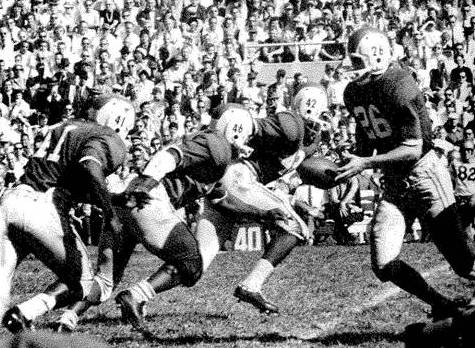

"Football '61 and Bob Ferguson"
HELMET REFLECTIONS FOR DECEMBER 2008
"Football '61 and Bob
Ferguson"
By Dr. Ken
During any football career, high
school, collegiate, or professional,
there are different motivating
factors for each individual
participant. My primary “push” as
high school began came from being
smaller than every other candidate
for the varsity football team and I
was madly in love with all aspects
of the game. There were players that
caught my attention the first time I
saw them play and gave me something
I could identify with or wished to
emulate. There were stars that every
fan and player was aware of, those
that stimulated Monday morning
conversation in offices, coffee
shops, and in my case, on the school
bus. The big time running backs on
the collegiate scene in 1961 were
Ernie Davis of Syracuse, Jimmy
Saxton of Texas, and Bob Ferguson of
Ohio State. HELMET HUT has had
numerous features about Ernie Davis
and the 2008 movie “The Express” on
site [ see http://www.helmethut.com/College/Syracuse/syracuseindex.html
] and without a doubt, he was one of
a kind. Saxton was a whirlwind back
with raw sprinter’s speed that
helped make Texas a national power,
renown in the Southwest for being
able to chase and catch jack rabbits
with his bare hands. Ferguson was
the type of back I could most
identify with and the prototype
Woody Hayes’ Ohio State fullback.
That Davis, Ferguson, and Saxton
finished one-two-three in the
Heisman Trophy race was no surprise
as each had a strong regional and
national following, and each brought
a dynamic and distinctive style to
the college game that season. The
1961 pre-season polls picked Iowa as
the class of the Big Ten with Ohio
State second or third based upon the
Buckeyes’ 7-2 finish in 1960 and
what appeared to be an unusually
strong backfield. Tom Matte had led
the ’60 squad from the quarterback
position before becoming a terrific
pro halfback with the Colts and his
running ability fully explained the
Hayes’ approach to offense. The
quarterback was a running back,
often gaining more yards than the
other backs in any specific game,
and the fullback was expected to be
the workhorse, carrying twenty to
thirty times each game and usually
between the tackles. Two great
tackles, Bob Vogel and Daryl
Sanders, were the driving force on
the offensive line, and both
destined for long and successful pro
careers. The quarterback position
was shared the entire season by
three capable players and future
Major League Baseball star Joe
Sparma served as the de facto
“designated passer” on the rare
occasions Hayes saw the need for
this approach. The rushing was left
to Ferguson, a 1960 All American who
punished tacklers and who had never
been tackled for a loss of yardage,
and halfbacks Paul Warfield and Matt
Snell.
 |
The super backfield that featured future pro stars and 1961's Maxwell Award winner
Sports Illustrated stated that
Ferguson “…probably is the best
college fullback to come along since
Jimmy Brown…” and summed up the 6’,
227 pound wrecking machine’s
physical running style as; “…who
pounds over opposing players on a
pair of stumpy legs that are about
the same circumference as the
average man’s waist.” In the biggest
game of the season against Iowa, the
fullback gained 144 yards on
twenty-seven carries, most of them
“…with four or five linemen hanging
on him.” Ferguson, who looked as if
he had been carved from stone when
he left Troy, Ohio for Columbus,
definitely had my attention, running
low to the ground in what was
usually a guaranteed three to five
yards and the expected Woody Hayes
“cloud of dust.” Despite the other
talented players, it was Ferguson
that was the focus of the team and
the bonus for me was the great
looking externally padded helmets
worn by the Buckeyes. After an
opening game 7-7 tie with Texas
Christian University and their 6’7”
quarterback Sonny Gibbs, the Bucks
ripped through their schedule. The
big showdown came against Iowa in
the
 |
Homecoming Game on November 4th
Bob Ferguson rips through Iowa in
pivotal game for Big Ten crown
End Charlie Bryant made the play of
the game, catching a pass from
Sparma and shrugging off almost
every member of the Iowa defense who
took a shot at bringing him down. He
finally settled into the end zone
sixty-three yards later with his
second touchdown of the day. Still,
it was the consistent pounding of
Ferguson that had the Iowa defense
exhausted by the third quarter and
the game ended with a 29-13 Buckeye
victory. Though the year would be
completed with an undefeated record,
a National Championship as awarded
by the Football Writers Association
Of America, and Ferguson being the
recipient of The Maxwell Award as
well as the second place Heisman
finish, a crushing disappointment
came with all of this as the Ohio
State Faculty Council vetoed the
Rose Bowl bid because they “felt
football was getting too big at Ohio
State.” Ferguson’s three year
performance included two unanimous
First Team All American selections,
2162 rushing yards, and a career
yards-per-carry average of more than
five yards. Ferguson was named to
the Ohio State All Century Team and
The College Football Hall Of Fame
and to many, remains the greatest of
all of Hayes’ fullbacks if not the
greatest in OSU history.
Unfortunately, after being drafted
in the first round by the Steelers,
he suffered a very severe concussion
early in his rookie season that
effectively ended his football
career. He hung on for the 1963
season with the Vikings and then
left the pro game. However, he
succeeded in the classroom by
earning his Masters degree in
sociology from Ohio State. Ferguson
was an obvious “I need to play like
that” role model for me as I sought
success as a high school running
back and I’m sure he did the same
for a legion of high school and
college players.